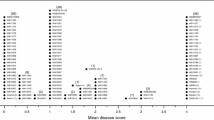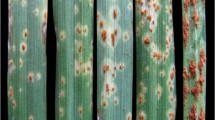Abstract
Barley powdery mildew caused by the fungus Blumeria graminis f. sp. hordei (Bgh) has emerged as the most damaging disease of barley in Western Australia (WA). Many of the available cultivars display high levels of disease in the field when climatic conditions are conducive. As a result, fungicides have become the main method of disease control in the last 10 years. Different types and sources of genetic disease resistance are available but to optimise their deployment it is necessary to evaluate the spectrum of pathotypes present in the pathogen population. Sixty isolates of Bgh were collected in the 2009 season from 9 locations, single spored and characterised by infection on reference barley lines and cultivars. Eighteen unique pathotypes were resolved. Virulence against many of the R-genes in the reference lines was present in at least one pathotype. Isolates were virulent against 16 out of a total of 23 resistance gene combinations. Undefeated resistance genes included the major R-genes Mla-6, Mla-9, Ml-ra and the combinations of Mla-1 plus Mla-A12 and Mla-6 plus Mla-14 and Mla-13 plus Ml-Ru3 together with the recessive resistance gene mlo-5. There was significant pathotype spatial differentiation suggesting limited gene flow between different regions with WA or localised selection pressures and proliferation. On the basis of the results we recommend a number of strategies to manage powdery mildew disease levels within WA.

Similar content being viewed by others
References
ABS (2012) Australian Bureau of Statistics. In ‘Principal Agricultural Commodities, Australia, 2010–2011.’ http://www.abs.gov.au/ausstats/abs@nsf/mf/7121.0)
Aghnoum R, Niks RE (2011) Transgressive segregation for very low and high levels of basal resistance to powdery mildew in barley. Journal of Plant Physiology 168(1):45–50
Brown JKM (1994) Chance and selection in the evolution of barley mildew. Trends Microbiol 2(12):470–475
Brown JKM (2002) Yield penalties of disease resistance in crops. Current Opinions in Plant Biology 5:1–6
Brown JKM, Wolfe MS (1990) Structure and evolution of a population of Erysiphe graminis f.sp. hordei. Plant Pathol 39(3):376–390
Buschges R, Hollricher K, Panstruga R, Simons G, Wolter M, Frijters A, van Daelen R, van der Lee T et al (1997) The barley Mlo gene: A novel control element of plant pathogen resistance. Cell 88:695–705
Chan KC, Boyd WJR (1992) Pathogenic variation of powdery mildew of barley in Western Australia. Aust J Agric Res 43:79–85
Chaure P, Gurr SJ, Spanu P (2000) Stable transformation of Erysiphe graminis an obligate biotrophic pathogen of barley. Nat Biotech 18(2):205–207
Czembor JH (2000) Resistance to powdery mildew populations of barley landraces from Morocco. Australasian Plant Pathology 29:137–148
Czembor JH, Johnston MR (1999) Resistance to powdery mildew in selections from Tunisian landraces of barley. Plant Breeding 118(6):503–509
DAFWA (2012) Barley variety guide for WA 2013. Department of Agriculture and Food, Government of Western Australia, No. 3836, Perth.
Dreiseitl A (2008) Virulence frequency to powdery mildew resistances in winter barley cultivars. Czech Journal of Genetics and Plant Breeding 44(4):160–166
Dreiseitl A, Platz G (2012) Powdery mildew resistance genes in barley varieties grown in Australia. Crop and Pasture Science, -.
Flor HH (1971) Current status of the gene-for-gene concept. Annu Rev Phytopathol 9:275–296
Freialdenhoven A, Peterhansel C, Kurth J, Kreuzaler F, Schulze-Lefert P (1996) Identification of genes required for the function of non-race-specific mlo resistance to powdery mildew in barley. The Plant Cell 8(1):5–14
Herrmann A, Löwer CF, Schachtel GA (1999) A new tool for entry and analysis of virulence data for plant pathogens. Plant Pathol 48(2):154–158
Hovmoller MS, Caffier V, Jalli M, Anderson O, Bessenhofer G, Czembor JH, Dreiseitl A, Felsenstein F et al (2000) The European barley powdery mildew virulence survey and disease nursery 1993–1999. Agronomie 20:729–743
Jones IT, Davies IJER (1985) Partial resistance to Erysiphe graminis hordei in old European barley varieties. Euphytica 34(2):499–507
Kjaer B, Jensen HP, Jensen J, Jorgensen JH (1990) Associations between three ml-o powdery mildew resistance genes and agronomic traits in barley. Euphytica 46:185–193
Kølster P, Munk L, Stølen O, Løhde J (1986) Near-isogenic barley lines with genes for resistance to powdery mildew. Crop Sci 26(5):903–907
McDonald BA, Linde C (2002) Pathogen population genetics, evolutionary potential and durable resistance. Annu Rev Phytopathol 40:349–379
Murray GM, Brennan JP (2010) Estimating disease losses to the Australian barley industry. Australasian Plant Pathology 39:85–96
Wyand RA, Brown JKM (2003) Genetic and forma specialis diversity in Blumeria graminis of cereals and its implications for host-pathogen co-evolution. Molecular Plant Pathology 4(3):187–198
Wyand RA, Brown JKM (2005) Sequence variation in the CYP51 gene of Blumeria graminis associated with resistance to sterol demethylase inhibiting fungicides. Fungal Genetics and Biology 42:726–735
Yu DZ, Yang XJ, Yang LJ, Jeger MJ, Brown JKM (2001) Assessment of partial resistance to powdery mildew in Chinese wheat varieties. Plant Breeding 120:279–284
Acknowledgements
This work was supported by funding from the Grains Research and Development Corporation GRS10035.
Author information
Authors and Affiliations
Corresponding author
Rights and permissions
About this article
Cite this article
Tucker, M.A., Jayasena, K., Ellwood, S.R. et al. Pathotype variation of barley powdery mildew in Western Australia. Australasian Plant Pathol. 42, 617–623 (2013). https://doi.org/10.1007/s13313-013-0226-y
Received:
Accepted:
Published:
Issue Date:
DOI: https://doi.org/10.1007/s13313-013-0226-y




